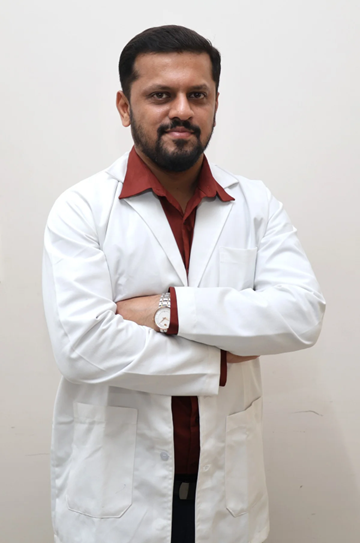
Arthroplasty Treatment in Hosakerehalli, Bangalore
Joint health plays a vital role in everyday life—whether it’s walking up stairs, taking a casual stroll, or playing with grandchildren. Worldwide, more than 300 million people live with osteoarthritis, and in India, nearly 30% of adults over 60 experience moderate to severe joint pain. Thankfully, progress in joint replacement is giving many people the chance to move comfortably again.
Dr. Nikil Parmesh, an acclaimed Orthopedic Surgeon in Hosakerehalli, Bangalore, shares:
“Protecting joint health is crucial, because pain and stiffness in the hips or knees can limit independence and reduce quality of life. By leveraging minimally invasive arthroplasty techniques, we aim to restore mobility quickly while preserving surrounding tissues. Our focus is on tailoring the procedure to each individual’s anatomy, activity level, and goals to ensure lasting outcomes.”
Arthroplasty Treatment Journey

First Consultation and Evaluation
Your journey begins with a full review of your medical history, lifestyle, and joint symptoms. Imaging tests like X-rays or MRIs help us understand the extent of joint damage. Based on this, we set clear goals and discuss what you can expect from treatment.
Creating Your Personalized Treatment Plan
We design a treatment plan just for you. This includes managing health conditions such as diabetes or high blood pressure before surgery. We also help you understand your implant options and explain the best surgical approach for your needs and routine.
Getting Ready for Surgery
Before the operation, you’ll go through basic tests like blood work and physical checks. You may be asked to do simple exercises to strengthen muscles. We also offer educational sessions to walk you through what happens before and after surgery.
Undergoing the Procedure
The surgery usually takes between 90 to 120 minutes and is done under spinal or general anesthesia. Small incisions are used to reduce tissue damage. Most patients are able to stand or walk with help the very next day. You may receive a partial or full joint replacement depending on your condition.
Recovery and Immediate Care
After surgery, pain is managed with medication and nerve blocks. You’ll start gentle walking and basic physiotherapy early to speed up healing. Standing or walking is encouraged as soon as it’s safe.
Long-Term Rehab and Monitoring
Rehabilitation continues for 6 to 12 weeks with guided physiotherapy to rebuild strength and movement. Follow-up appointments help us check the position and function of your implant. You’ll also get advice on long-term joint care and daily activity habits.
Types of Arthroplasty Procedures Offered by Dr. Nikil S Paramesh
Total Knee Arthroplasty
Ideal for advanced knee arthritis or irreparable damage. Damaged cartilage and bone are replaced with prosthetic components, restoring smooth joint function.
Partial (Unicompartmental) Knee Arthroplasty
Only the damaged compartment of the knee is replaced, preserving healthy cartilage and allowing a faster recovery.
Total Hip Arthroplasty
A full hip replacement procedure where worn-out cartilage and bone are replaced with prosthetic components, relieving pain and enhancing stability.
Revision Arthroplasty
Performed in cases of implant loosening, infection, or wear of existing prosthesis—often more complex but still customized to give renewed joint function.
Curious how specific joint issues are addressed? Here’s the breakdown.
Common Conditions Treated with Arthroplasty
Osteoarthritis – progressive cartilage loss in weight-bearing joints leading to pain and stiffness
Rheumatoid Arthritis – inflammatory arthritis causing joint erosion and deformity
Post-Traumatic Arthritis – arthritis that develops after joint fractures or injuries
Avascular Necrosis – bone death due to disrupted blood flow, common in hips
Severe Joint Pain or Deformity – shown when conservative treatment fails and mobility is still impaired
Comparing Arthroplasty vs. Other Joint-Saving Options
Here’s how treatments stack up:
Physiotherapy & Lifestyle Modification
Ideal for mild symptoms; includes exercises and activity adjustments—but often insufficient when cartilage damage is advanced.
Medication & Injections
NSAIDs and corticosteroid or viscosupplement injections can manage symptoms temporarily, but repeated use carries risks (e.g., GI irritation, infection, or tendon degeneration).
Arthroscopic Debridement
Useful in select cases (e.g., meniscal tears, loose fragments); provides only short-term relief in inflammatory or advanced osteoarthritis.

Arthroplasty (Joint Replacement)
Proven to offer substantial pain relief and functional improvement when non-surgical options are exhausted. It can provide a joint that functions like new.
Why Choose Dr. Nikil S Paramesh for Arthroplasty

Extensive Expertise
With 12+ years of dedicated experience in joint replacement, he’s treated hundreds of patients from Bangalore and beyond.
State-of-the-Art Techniques
Uses minimally invasive, muscle-sparing methods for less pain and quicker recovery.
Customized, Evidence-Based Care
Surgical plans are informed by global success statistics and aligned with Indian population needs—ensuring optimal recovery.
Patient-Centric Approach
Prioritizes open communication, clarity on anatomy, procedure options, and post-op care goals.
Comprehensive Support Systems
Dedicated physiotherapy, nurse-coordinated care, and timely follow‑ups guarantee ongoing progress.

Frequently Asked Questions
1. Is arthroplasty painful?
2. Benefits and Risks of Arthroplasty
Benefits: Significant pain relief; increased mobility; durable implants lasting 15–20 years; improved quality of life.
Risks: Infection (<1%), blood clots, implant wear or loosening (rare), nerve irritation. Pre‑op optimization and sterile techniques significantly reduce these.
3. How long does arthroplasty surgery take?
4. Are there any food or activity restrictions after surgery?
5. Will I need physiotherapy after arthroplasty?
5. Can arthroplasty be done under spinal anesthesia?
Disclaimer: This page is for informational purposes and not for promotional use.


